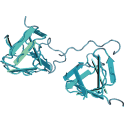
- Remove this product from my favorite's list.
- Add this product to my list of favorites.
Products
Newsletter
 |  |  |  |  |  |

Background: The p21-activated kinases (PAKs) belong to the group of serine/threonine protein kinases and are subdivided into two groups, PAK1-3 (group I) and PAK4-6 (group II), based on sequence similarities and an autoinhibitory domain which is present in group I, but not group II PAK. PAKs in general have similar structural organization, including an N-terminal regulatory domain containing a p21 binding domain (PBD) and an auto-inhibitory domain (AID), and a C-terminal catalytic domain. Binding of Cdc42/Rac1 to PAK2 changes its conformation relieves the auto-inhibition, frees the kinase domain and resulting in its activation. Additionally, apoptotic stimuli lead to caspase-mediated cleavage of PAK2, generating a constitutively active kinase fragment p34 and an N-terminal regulatory fragment p27. PAK2 is the major PAK expressed in T cells and is an essential regulator that drives the actin cytoskeleton-dependent signaling for normal thymocyte development and maturation. Furthermore, PAK2 negatively modulate TGF-β signaling by association with Smad2 and Smad3 in a kinase activity-dependent manner and thereby blocking their activation.
Recombinant human PAK2 protein kinase, amino acids D3-R524 (as in GenBank entry NM_002577)*, N-terminally fused to GST-HIS6-Thrombin cleavage site
Theoretical MW : 87.9 kDa (fusion proteins)
Expression system: Baculovirus infected Sf9 cells
Purification: One-step affinity purification using glutathione agarose
Storage buffer: 50 mM Tris-HCl, pH 8.0; 100 mM NaCl, 5 mM DTT, 15 mM reduced glutathione, 20% glycerol
Protein concentration: 0.403 mg/ml (Bradford method using BSA as standard protein)
Method for determination of Km value & specific activity: Filter binding assay MAPH membrane
Specific activity : 228,000 pmol/mg x min
Entrez Gene ID: 5602
UniProtKB: Q13177
Ordering information: shipped on dry ice
Yan X1, Zhang J, Sun Q, Tuazon PT, Wu X, Traugh JA, Chen YG. (2012) "p21-Activated kinase 2 (PAK2) inhibits TGF-β signaling in Madin-Darby canine kidney (MDCK) epithelial cells by interfering with the receptor-Smad interaction."J Biol Chem.;287(17):13705-12.
Phee H1, Au-Yeung BB2, Pryshchep O3, O'Hagan KL3, Fairbairn SG3, Radu M4, Kosoff R4, Mollenauer M2, Cheng D2, Chernoff J4, Weiss A5. (2014) "Pak2 is required for actin cytoskeleton remodeling, TCR signaling, and normal thymocyte development and maturation." Elife. 2014 May 13;3:e02270. doi: 10.7554/eLife.02270.
Whale A, Hashim FN, Fram S, Jones GE, Wells CM. (2011) "Signalling to cancer cell invasion through PAK family kinases." Front Biosci (Landmark Ed). 1;16:849-64.
Wang J., Wu J.W., Wang Z.X. (2011) "Structural insights into the autoactivation mechanism of p21-activated protein kinase."Structure 19:1752-1761
Recombinant human serine/threonine-protein kinase PAK1, 10µg - 465,00 €
Recombinant human Misshapen-like kinase 1 (MINK1), protein kinase domain, 10 µg - 465,00 €
Recombinant human Mammalian Sterile20-like kinase 1 (Mst1), 10 µg - 465,00 €
Recombinant human serine/threonine-protein kinase PAK3, 10 µg - 465,00 €
Recombinant human serine/threonine-protein kinase PAK 7, 10 µg - 465,00 €
Welcome Login
Contact us
Follow us